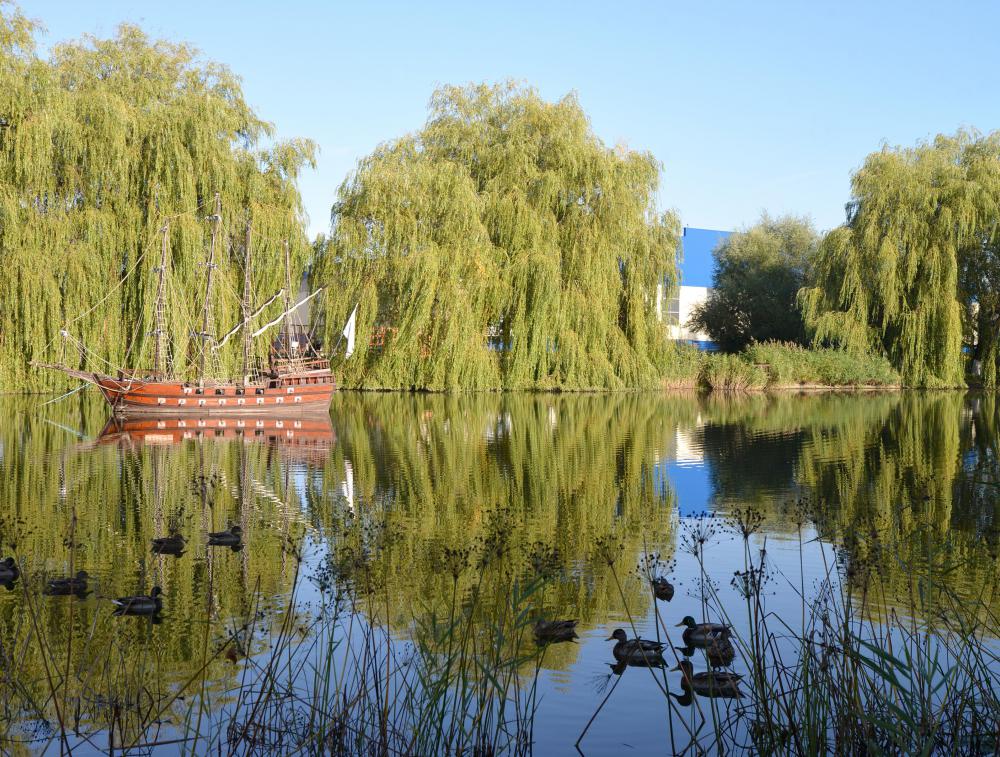At AllThingsNature, we're committed to delivering accurate, trustworthy information. Our expert-authored content is rigorously fact-checked and sourced from credible authorities. Discover how we uphold the highest standards in providing you with reliable knowledge.
What is a Willow Tree?
A willow tree is a tree in the genus Salix, which contains around 400 distinct species of trees and shrubs native to the Northern hemisphere. Willows prefer cool, moist environments, and they are found in both cold and temperate regions of the Northern hemisphere along the banks of rivers and marshes. Willow trees have a number of commercial uses, and the trees are also frequently planted as ornamentals, since some species have quite attractive growth habits.
Several traits are common to all willow trees. As a general rule, their leaves are narrow, and they produce flowers in the form of catkins. The wood of willow trees is famous for being both lightweight and strong, making it a popular material for everything from furniture to cricket bats. Willows are also very promiscuous, hybridizing freely with other trees and growing from both cuttings and aerial roots. This can be a problem when people are attempting to eliminate willows, as is the case in some areas where they are choking out native species.

A willow which has evolved in cooler regions of the world tends to take the form of a creeping shrub, rather than a tree, reflecting a desire to protect itself from severe weather and cold. Willows which develop in warmer regions will be much larger, often with very delicate branches which easily snap off, allowing the tree to propagate itself. Willows with especially narrow leaves are sometimes known as osiers, while wide-leaved willows are called sallows.

One famous willow tree hybrid is the weeping willow, which has long, trailing branches. Weeping willows are associated with sorrow both in their native China and in many parts of Europe. Pussy willows, another well known willow varietal, are famous for producing soft, fuzzy catkins in the spring, and they are often collected and brought into the home to celebrate the beginning of spring.

Willow wood can be used in a wide variety of projects, and the bark has historically been used to make medicines, as it contains salicylic acid, the original aspirin. Because willows grow quickly and establish extensive root systems, they have also historically been used to control erosion. The trees are also quite popular among butterflies, leading some people to plant willows to attract butterflies to their yards and gardens.
Many garden supply stores carry a willow tree selection, and they can order specific varieties, should customers so desire. Before planting a willow tree, it is a good idea to think carefully about placement, as these trees can grow extremely tall, overshadowing the area around them. The willow tree is also deciduous, dropping its leaves during the winter months, and this can create quite a mess to clean up.
Frequently Asked Questions
What is a willow tree and how can it be identified?
A willow tree is a type of deciduous plant known for its flexibility and the elegance of its hanging branches. It can be identified by its narrow leaves, which are typically light green and elongated, and its bark, which varies from smooth in younger trees to deeply furrowed in older specimens. Willows often grow near water sources and have a distinctive, graceful appearance.
Where do willow trees commonly grow?
Willow trees thrive in moist soils and are commonly found in temperate regions across the Northern Hemisphere. They are especially prevalent along riverbanks, lakesides, and in wetlands. Their preference for wet environments is due to their high water demand, which their extensive root systems help to satisfy by drawing water from deep underground or from nearby water sources.
What are some common uses for willow trees?
Historically, willow trees have been valued for their wood, which is light yet strong, and particularly flexible. This makes it ideal for woven products like baskets and furniture. Additionally, the bark of some willow species contains salicin, a compound that was the precursor to aspirin, thus having medicinal uses. Willows are also used for soil erosion control and as ornamental plants in landscapes.
Are there different types of willow trees?
Yes, there are over 400 species of willow trees, ranging from small shrubs to large trees. Some of the most well-known species include the weeping willow, known for its drooping branches, and the white willow, named for the white underside of its leaves. Each species has adapted to its environment, with variations in size, leaf shape, and habitat preferences.
How do willow trees benefit the ecosystem?
Willow trees play a crucial role in their ecosystems by stabilizing soil and preventing erosion, especially along waterways. Their dense root systems filter water, improving water quality. Willows also provide habitat and food for wildlife, including birds, insects, and mammals. Their early spring flowers offer an important nectar source for pollinators emerging from hibernation.
Can willow trees be grown in a home garden?
Willow trees can be a beautiful addition to a home garden, but they require careful consideration due to their size and water needs. They should be planted in a spacious area away from buildings and septic systems, as their roots can be invasive. With proper space and access to water, willows can create a serene and picturesque environment in a home landscape.
AS FEATURED ON:
AS FEATURED ON:













Discussion Comments
Maybe the job of the willows is to keep banks of streams from eroding. The willow tree will start growing from a twig, if there is sufficient moisture in the soil.
Post your comments